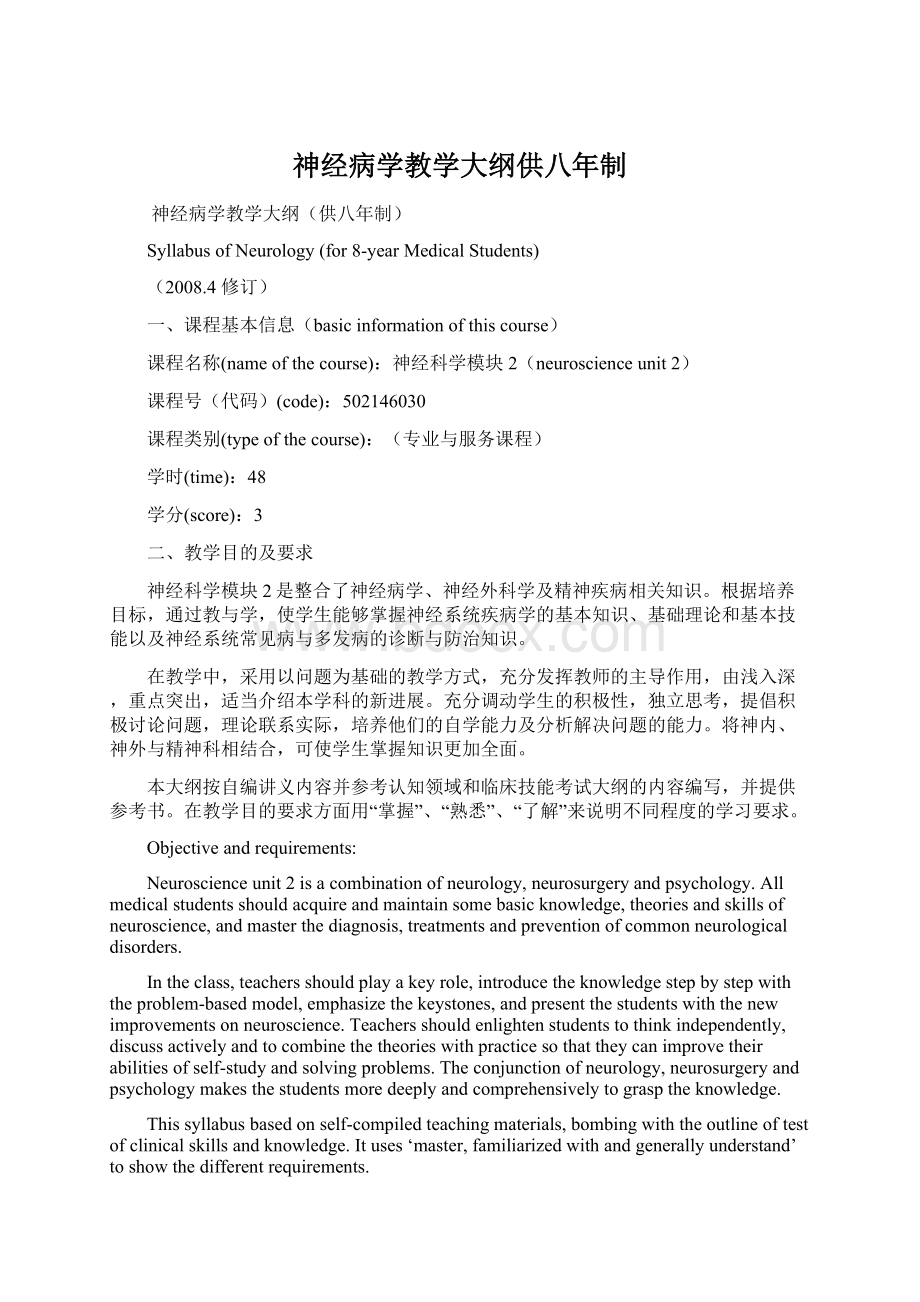神经病学教学大纲供八年制.docx
《神经病学教学大纲供八年制.docx》由会员分享,可在线阅读,更多相关《神经病学教学大纲供八年制.docx(30页珍藏版)》请在冰豆网上搜索。

神经病学教学大纲供八年制
神经病学教学大纲(供八年制)
SyllabusofNeurology(for8-yearMedicalStudents)
(2008.4修订)
一、课程基本信息(basicinformationofthiscourse)
课程名称(nameofthecourse):
神经科学模块2(neuroscienceunit2)
课程号(代码)(code):
502146030
课程类别(typeofthecourse):
(专业与服务课程)
学时(time):
48
学分(score):
3
二、教学目的及要求
神经科学模块2是整合了神经病学、神经外科学及精神疾病相关知识。
根据培养目标,通过教与学,使学生能够掌握神经系统疾病学的基本知识、基础理论和基本技能以及神经系统常见病与多发病的诊断与防治知识。
在教学中,采用以问题为基础的教学方式,充分发挥教师的主导作用,由浅入深,重点突出,适当介绍本学科的新进展。
充分调动学生的积极性,独立思考,提倡积极讨论问题,理论联系实际,培养他们的自学能力及分析解决问题的能力。
将神内、神外与精神科相结合,可使学生掌握知识更加全面。
本大纲按自编讲义内容并参考认知领域和临床技能考试大纲的内容编写,并提供参考书。
在教学目的要求方面用“掌握”、“熟悉”、“了解”来说明不同程度的学习要求。
Objectiveandrequirements:
Neuroscienceunit2isacombinationofneurology,neurosurgeryandpsychology.Allmedicalstudentsshouldacquireandmaintainsomebasicknowledge,theoriesandskillsofneuroscience,andmasterthediagnosis,treatmentsandpreventionofcommonneurologicaldisorders.
Intheclass,teachersshouldplayakeyrole,introducetheknowledgestepbystepwiththeproblem-basedmodel,emphasizethekeystones,andpresentthestudentswiththenewimprovementsonneuroscience.Teachersshouldenlightenstudentstothinkindependently,discussactivelyandtocombinethetheorieswithpracticesothattheycanimprovetheirabilitiesofself-studyandsolvingproblems.Theconjunctionofneurology,neurosurgeryandpsychologymakesthestudentsmoredeeplyandcomprehensivelytograsptheknowledge.
Thissyllabusbasedonself-compiledteachingmaterials,bombingwiththeoutlineoftestofclinicalskillsandknowledge.Ituses‘master,familiarizedwithandgenerallyunderstand’toshowthedifferentrequirements.
三、教学内容(表1)
含各章节主要内容、学时分配,并以下划线或*等方式注明重点、
难点。
表1教学内容
章节
题目
课时
1
总论
4
2
缺血性脑血管病
4
3
出血性脑血管病
4
4
癫痫、帕金森病
4
5
脊髓疾病
4
6
中枢神经系统感染、脑器质性精神障碍、周围神经疾病、肌肉疾病
4
7
神经变性疾病、神经遗传性疾病、脱髓鞘疾病
4
8
头痛、颅内压增高及脑疝
4
9
颅脑外伤、肿瘤
4
合计
36
Table1Lecturingcontents
chapter
title
Time(class)
1
Introduction
4
2
IschemicCerebrovascularDiseases
4
3
HemorrhagicCerebrovascularDiseases
4
4
Epilepsy,Parkinson’sdisease
4
5
Spinalcorddiseases
4
6
InfectionsofCNS,psychologyassociatedduetobraindisease,PeripheralNeuropathy,musculardiseases
4
7
Neurodegenerationandneurogeneticdisease,Multiplesclerosis
4
8
Headache,IntracranialHypertensionandBrainHerniation
4
9
craniocerebraltrauma;braintumor
4
sum
36
四、教材(名称、作者、出版社、出版时间)
自编讲义
五、主要参考资料
1.MERRITT’SNeurology
2、《实用神经病学》主编:
史玉泉2003.7.
3、《神经外科手术学》主编:
王忠诚
4、OxfordTextbookofPsychiatry
六、成绩评定(注明期末、期中、平时成绩所占的比例,或理论考
核、实践考核成绩所占的比例):
期末理论考核成绩
——————————————————————————————
备注:
1、各学院可根据参考格式,结合本学科课程的特点,另行规范教学大纲的格式,但本学院所开各门课程的教学大纲必须统一格式。
2、每门本科课程都必须有教学大纲。
教学大纲的内容要符合培养目标要求,服从课程体系结构及教学安排的整体需要。
教学大纲由教研室组织有关教师编写,经学院或教研室认定后施行,并注意根据每轮教学的具体情况及时更新、修订大纲内容。
教师在教学过程中原则上应当严格执行教学大纲。
3、学院开出的各门本科课程的教学大纲均应上网(学院网页),并在上第一次课时就告诉学生,以便于学生查询。
总论
(Introduction)
(神经系统解剖、生理、定位诊断与神经系统检查、辅助检查)
【目的要求】
一、掌握内容:
1、意识障碍的分类
2、运动性、感觉性、命名性及混合性失语
3、感觉、运动系统的定位诊断及感觉障碍与瘫痪的类型
4、脑不同部位损害的临床表现
5、脑脊液各项指标的正常值
二、熟悉内容:
1、特殊类型的意识障碍及脑死亡
2、视、动眼、三叉、外展、面、舌咽、迷走神经和舌下神经受损时的主要症状体征,特别是眼肌麻痹的分类与表现
3、常见不自主运动及共济失调类型
4、深、浅及病理反射的临床意义
5、神经系统疾病的病史采集和临床常规检查方法以及与各论中疾病有关的定位诊断
三、了解内容:
神经电生理、影像学检查的意义及基因学诊断技术
【Objectives】
Aftercompletingofthischapter,youshouldhaveachievedthefollowinggoals:
1、Masterclassificationofconsciousnessdisorder
2、Masterthemotoraphasia,sensoryaphasia,amnesicaphasiaandtotalaphasia
3、Masterthetopographicdiagnosisofmotorandsenselesions,typesofparalysisandsensorydisorders.
4、Masterthesymptomsandsignsoflesionsofdifferentpartofthebrain
5、Masterthenormalvaluesofcerebralspinalfluid(CSF)inspection
6、Familiarwith:
specialtypesofconciousnessandbraindeath
7、Familiarwiththemainmanifestationsoflesionsofopticnerve、oculomotornerve、abducentnerve、trigeminalnerve、facialnerve、glossopharyngealnerve、vagusnerveandhypoglossalnerve;especiallythemanifestationsofophthalmoplegia
8、Familiarwiththefrequenttypesofinvoluntarymovementsandataxia
9、theclinicalimportancesofsuperfacialreflexes,deepreflexesandabnormalreflexes
10、Familiarwith:
Themethodofhistorycollectionandroutineclinicalexamination,relativetopographicdiagnosis
11、Knowingtheelectrophysiology,imagingstudies,andgeneticinvestigationsinneurology
【教学时数】4课时
【lecturingtime】4class
【教学内容】
一、意识障碍的分类及特殊类型的意识障碍、脑死亡
二、常见的失语(运动、感觉及混合性失语)及构音障碍的解剖基础与临床表现
三、视、动眼、滑车、外展、面、舌咽、迷走、舌下等颅神经损害的主要症状、体征,核上、下型眼肌麻痹表现
四、感觉系统
1、感觉的分类:
特殊感觉、一般感觉、复合感觉
2、深浅感觉的传导通路、主要节段支配
3、感觉障碍的几种类型
4、各种感觉障碍的临床表现和感觉障碍的定位诊断(皮质、内囊、脑干、脊髓、周围神经损害的特点)。
五、运动系统
1、运动系统包括的范围(随意运动、锥体外系统及小脑系统),随意运动系统的传导解剖通路
2、随意运动障碍及上、下运动神经元瘫痪的鉴别
3、瘫痪的定位诊断(皮质、内囊、脑干、脊髓及损害表现)
4、锥体外系统运动障碍,不自主运动、肌张力变化
(1)不自主运动:
震颤、痉挛、抽搐、舞蹈样动作、手足徐动症及扭转痉挛
(2)肌张力变化:
强直性增高、变型性肌张力障碍、肌张力降低。
5、小脑系统运动障碍:
共济失调的临床表现及检查方法
六、反射系统
深、浅反射的改变,病理反射的临床意义,常见几种病理反射
七、大脑、小脑、脑干的解剖及各部位损害的临床特点。
八、辅助检查
1、脑脊液:
压力及各项指标正常值、电生理(脑电图、肌电图、诱发电位)、组织显像(CT、MRI、同位素等)等项检查的临床意义,组织活检(肌肉、神经、脑)的临床意义。
2、神经电生理、影像学检查的意义及基因学诊断技术(自学)
【lecturingcontents】
1、Classificationofconsciousdisturbance,specialtypesofconciousness,braindeath
2、Manifestationofdifferentaphasiaandtheirlocalization;theanatomyandmanifestationofdysphasia
3、themainmanifestationsoflesionsof:
opticnerve、oculomotornerve、abducentnerve、trigeminalnerve、facialnerve、glossopharyngealnerve、vagusnerveandhypoglossalnerve;themanifestationsofupperandlowermotorneuronparalysisofextraocularmuscles
4、Sensorysystem:
(1)classificationofsensation:
specialsensation,commonsensation,complexsensation
(2)theconductingcontractpathwayofsuperfacialanddeepsensation;mianspreadingsection
(3)classificationofsensationaldisorders
(4)manifestationofeachkindsofsensationandthetopographydiagnosisofsensationaldisturbances(cortex,internalcapsule,brainstem,spinalcord,peripheralnerve)
5、Movementsystem:
(1)Aspectofmovementsystem(voluntarymovement,extrapyrimidalsystemandcerebellarsystem),theconducttractpathwayofvoluntarymovementsystem
(2)Disturbancesofvoluntarymovement;differentiationoftheupperandthelowermotorneuronparalysis
(3)topographydiagnosisofpalsy(cortex,internalcapsule,brainstem,spinalcord)
(4)Disturbancesofextrapyrimidalsystem;involuntarymovement,changingofmusclartone
Involuntarymovement:
tremor,spasm,tic,andsoon
Changingofmusculartone:
rigidity,andsoon
(5)Disturbancesofcerebellarsystem:
manifestationandexaminationofataxia
6、Reflexsystem
Changingofsuperficial,deepreflex,clinicalimportanceofpathologicalchanges,pathologicalreflexesfoundofteninclinic
7、TheanatomyandthemanifestationoflesionsoftheCortex、Cerebellum、Brainstem:
anatomy,signsandsymptoms
8、Investigativestudies:
(1)CSF:
pressure,normalvalues.Electrophysiology(EEG,EMG,EP);Tissueimaging(CT,MRI,andsoon);Tissuebiopsy(muscle,nerve,brain)
(2)electrophysiology,imagingstudies,andgeneticinvestigationsinneurology(studyingbystudentsthemselves)
缺血性脑血管疾病
(IschemicCerebrovasculardiseases)
【目的要求】
一、掌握内容:
掌握脑动脉血栓形成和脑栓塞的临床表现、诊断、鉴别诊断和治疗原则
二、熟悉内容:
熟悉短暂性脑缺血发作的概念、特点及治疗措施
三、了解内容:
1、了解缺血性脑血管疾病的分类,危险因素和预防
2、了解腔隙性及分水岭脑梗死的概念,临床特点及治疗措施
3、了解静脉窦血栓形成的定义、病因、分类及诊断与治疗原则
4、了解缺血性脑血管病的外科治疗
【Objectives】
1、Master:
theclinicalmanifestation,diagnosis,differentialdiagnosisandtreatmentprincipleofcerebralinfarction,apoplexyandsubarachnoidhemorrhage
2、Familiarwith:
theconception,manifestationandtreatmentoftransientischemicattack.
3、Knowing:
classification,riskfactorandpreventionofischemiccerebrovasculardisease.
Kowning:
conception,cause,,classification,diagnosisandtreatmentofcerebralvenousthrombosis
Knowing:
conception,clinicalmanifestation,treatmentoflacunarinfarction,cerebralwatershedinfarction
Knowing:
thesurgicaltreatmentofischemiccerebrovasculardisease
【教学时数】4课时
【lecturingtime】4classes
【教学内容】
1、脑血管应用解剖
2、缺血性脑血管疾病的分类,危险因素和预防
2了解急应用解剖、3、动脉血栓性脑梗死的病因和发病机制、病理、临床表现、诊断和鉴别诊断、治疗原则
3、脑栓塞的病因和发病机制、病理、临床表现、诊断和鉴别诊断、治疗原则
4、短暂性脑缺血发作的病因、临床特点、诊断、治疗
5、腔隙性脑梗死的定义,病因、临床表现、诊断和治疗
6、分水岭脑梗死的定义,病因、临床表现、诊断和治疗。
7、静脉窦血栓形成的定义、病因、分类及诊断与治疗原则
8、缺血性脑血管病的外科治疗:
颈内动脉内膜切除术,恶性大脑中动脉综合征的外科治疗
【lecturingcontents】
1、Bloodsupplyofthebrain
2、Classfication,riskfactorsandpreventionofischemiccerebrovasculardisease
3、Theetiology,pathogenesis,clinicalmanifestation,diagnosis,differentialdiagnosisandtreatmentprinciplesofcerebralthrombosis
3、Theetiology,clinicalmanifestation,diagnosis,differentialdiagnosisandtreatmentprinciplesofcerebralembolism
4、Theetiology,clinicalmanifestation,diagnosis,andtreatmentprinciplesoftransientischemicattack.
5、Conception,cause,manifestation,diagnosisandtreatmentoflacunarinfarction
6、Conception,cause,manifestation,diagnosisandtreatmentofcerebralwatershedinfarction
7、Conception,cause,manifestation,diagnosisandtreatmentofcerebralvenousthrombosis
8、thesurgicaltreatmentofischemiccerebrovasculardisease:
CarotidEndarterectomy;thesurgicaltreatmentofmalignantMCAsyndrome.
出血性脑血管病
(HemorrhagicCerebrovasculardiseases)
【目的要求】
1、掌握脑出血和蛛网膜下腔出血的临床表现、诊断、鉴别诊断和内、外科治疗原则
3、了解出血性脑血管疾病的分类,危险因素和预防
【Objectives】
1、Master:
theclinicalmanifestation,diagnosis,differentialdiagnosisandmedicalandsurgicalmanagementprincipleofcerebralhemorrhageandsubarachnoidhemorrhage
2、Knowing:
Theclassification,riskfactorsandpreventionofhemorrhagiccerebrovasculardiseases
【教学时数】4课时
【lecturingtime】4classes
【教学内容】
1、出血性脑血管疾病的分类,危险因素和预防
2、脑出血的病因、发病原理、病理、临床表现、诊断和鉴别诊断、治疗原则、外科手术指征、预防。
3、蛛网膜下腔出血的病因、病理、临床表现、辅助检查、诊断、鉴别诊断和内科及外科治疗原则。
【lecturingcontents】
1、Theclassification,riskfactorsandpreventionofhemorrhagiccerebrovasculardiseases
2、Theetiology,pathogenesis,clini